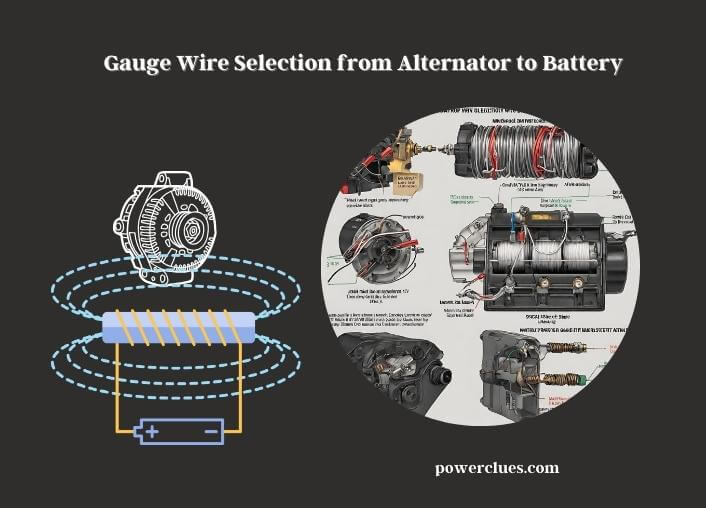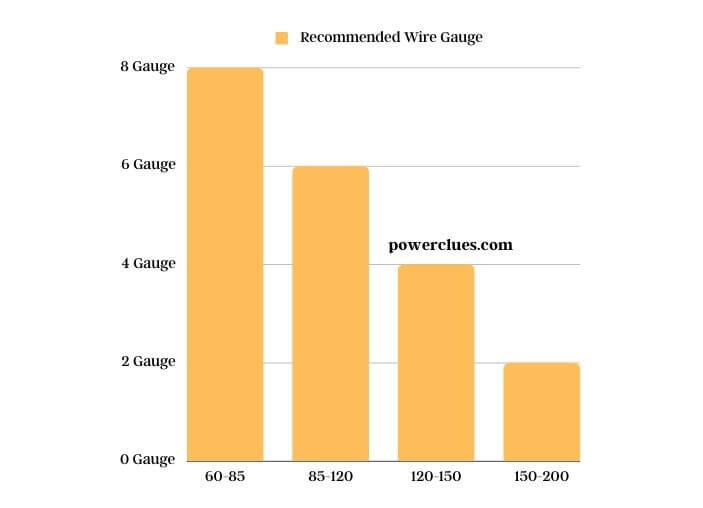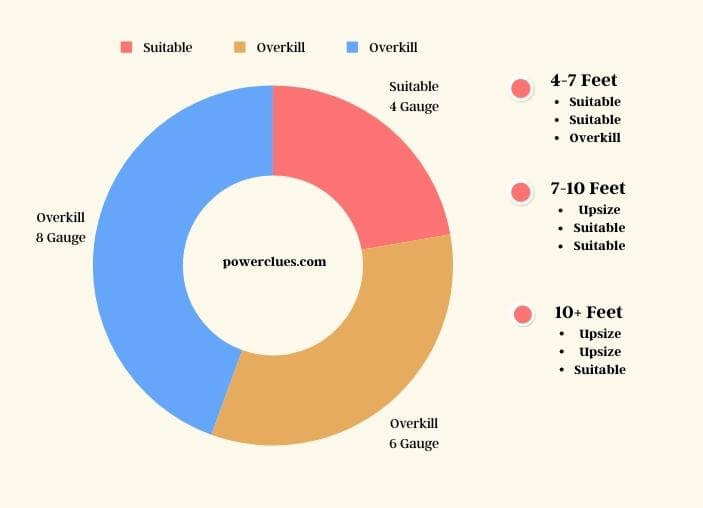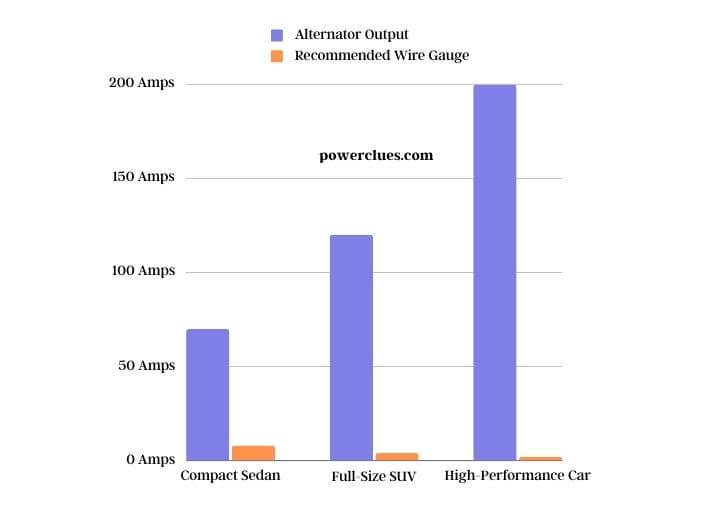Gauge Wire Selection from Alternator to Battery – Essential Guide
The ideal gauge wire from an alternator to a battery is typically 4 gauge. This size ensures efficient power transfer and reduces voltage drop, especially in systems with high-output alternators.
Selecting the right wire size for connecting an alternator to a battery is vital for the health and efficiency of your vehicle’s electrical system. The wire gauge needed can vary based on the alternator’s amperage output and the distance between the alternator and the battery. For instance, a 140 amp alternator might require a thicker wire, possibly 4 gauge, to handle the higher current flow. In contrast, a system with a 200 amp alternator demands even thicker wiring, often around 2 gauge, to ensure safe and efficient operation.
The length of the wire also plays a crucial role. Longer distances between the alternator and battery may require a thicker wire to compensate for potential voltage drop. For example, 6 gauge wire might be sufficient for shorter runs, but 4 gauge or even 2 gauge might be necessary for longer distances. This consideration is also relevant when wiring from the alternator to the starter, as the starter can draw significant current.
An alternator wire size chart can be a handy reference tool in these scenarios. It helps in determining the appropriate wire gauge for different alternator amperages and distances. For instance, an 8 gauge wire might be suitable for lower amperage alternators or shorter distances.
For those interested in ensuring their vehicle’s electrical system is optimally configured, a detailed article below provides more insights. It covers various aspects of choosing the right alternator wire size, including specific scenarios and additional technical details.

What Gauge Wire From Alternator to Battery?
Understanding Wire Gauge Basics
Definition of Wire Gauge
Wire gauge is a standard unit of measure used to determine the diameter of electric wires. In the world of automotive electrical systems, the right wire gauge is key to ensuring safe and efficient power transfer. It’s like choosing the right-sized pipes for water flow; too small, and you risk a bottleneck, too large, and it’s overkill.
Significance in Electrical Systems
In your car’s electrical system, the wire gauge plays a pivotal role. It’s not just about making connections; it’s about ensuring these connections can handle the electrical current without overheating or causing voltage drops. Think of it as the lifeline for your car’s electrical components, delivering the right amount of power where it’s needed.
Factors Influencing Wire Gauge Selection
Amperage Output of the Alternator
The alternator’s amperage output is like the heart rate of your car’s electrical system. Higher amperage alternators need thicker wires to handle the increased flow of electricity. It’s a balancing act – too thin, and you risk overheating; too thick, and it’s unnecessary expense and bulk.
Distance Between Alternator and Battery
Distance matters in wire gauge selection. Longer distances between the alternator and battery can lead to voltage drops. It’s like running a marathon; the longer the run, the more energy (or in this case, power) is lost along the way. Selecting the right wire gauge compensates for this loss, ensuring efficient power delivery.
Voltage Drop Considerations
Voltage drop is the electrical world’s equivalent of friction loss. It’s the reduction in voltage as electricity travels along the wire. Minimizing voltage drop is crucial, especially in high-demand electrical systems. The right wire gauge ensures your car’s electrical components get the power they need without strain.
Wire Gauge Selection for Different Amperage Outputs
Recommended Wire Gauges for Various Amperage Levels
| Alternator Output (Amps) | Recommended Wire Gauge |
| 60-85 | 8 Gauge |
| 85-120 | 6 Gauge |
| 120-150 | 4 Gauge |
| 150-200 | 2 Gauge |

Case Studies: Real-World Scenarios
Let’s look at some real-life examples. A standard sedan with a 70-amp alternator runs perfectly on 8 gauge wire. But, if you’re upgrading to a 140-amp alternator for high-performance audio systems, stepping up to 4 gauge wire is a smart move. It’s all about matching the wire to the workload.
Impact of Distance on Wire Gauge Choice
Calculating Voltage Drop Over Distance
Calculating voltage drop is crucial for long-distance connections. It’s like planning a road trip; you need to account for fuel consumption over the distance. In electrical terms, this means upsizing the wire gauge to ensure consistent power delivery to your battery.
Adjusting Wire Gauge for Longer Runs
For longer runs, upsizing the wire gauge is a wise choice. It’s like wearing the right shoes for a long hike; the better the fit, the smoother the journey. In electrical terms, a thicker wire for longer distances means less resistance and a healthier electrical system.
Wire Gauge Adjustments for Distance
| Distance (Feet) | Up to 4 Feet | 4-7 Feet | 7-10 Feet | 10+ Feet |
| 4 Gauge | Suitable | Suitable | Upsize | Upsize |
| 6 Gauge | Overkill | Suitable | Suitable | Upsize |
| 8 Gauge | Overkill | Overkill | Suitable | Suitable |

Special Considerations for High-Output Alternators
Handling 140 Amp and 200 Amp Alternators
High-output alternators, like those rated at 140 or 200 amps, are the heavy lifters in the electrical world. They demand respect and the right wire gauge. Using 4 gauge wire for a 140 amp alternator and 2 gauge for a 200 amp ensures that these powerhouses operate safely and efficiently.
Upgraded Wiring Needs for High-Performance Vehicles
High-performance vehicles with powerful alternators are like athletes needing the right gear. Upgraded wiring is not just an option; it’s a necessity. It ensures that every bit of power is delivered effectively, keeping your high-performance vehicle in top electrical shape.
Practical Tips for Installation and Maintenance
Best Practices for Wire Installation
Installing wires is not just about connecting A to B. It’s about ensuring a secure, clean, and efficient setup. Use quality connectors, ensure tight connections, and route wires away from heat sources. It’s like setting up a home theater system; the right setup leads to the best performance.
Safety Precautions and Maintenance Tips
Safety first! Always disconnect the battery before working on your car’s electrical system. Regularly check your wires for wear and tear, just like you would check your car’s oil. Preventive maintenance goes a long way in avoiding electrical mishaps.
Real-World Examples and Case Studies
Comparative Analysis of Different Vehicle Models
| Vehicle Model | Alternator Output | Recommended Wire Gauge |
| Compact Sedan | 70 Amps | 8 Gauge |
| Full-Size SUV | 120 Amps | 4 Gauge |
| High-Performance Car | 200 Amps | 2 Gauge |

Lessons Learned from Practical Applications
From compact cars to high-performance vehicles, each has its unique electrical demands. A compact sedan runs just fine on 8 gauge wire, while a high-performance car with a 200 amp alternator needs the robustness of 2 gauge wire. Tailoring the wire gauge to the vehicle ensures optimal performance and longevity.
FAQs
Can Different Climates Affect Wire Gauge Choice?
Absolutely, climate can influence wire gauge selection. In extremely cold environments, wires can become more brittle and less conductive. This means you might need a slightly larger gauge to ensure consistent performance. Conversely, in very hot climates, wires can expand and become more prone to wear. Here, a robust wire with a higher heat tolerance is advisable. Always consider your local climate when selecting the wire gauge for your alternator to battery connection. It’s like dressing appropriately for the weather; the right choice keeps your car’s electrical system ‘comfortable’ and functioning optimally.
Is There a Difference in Wire Gauge Needs for Diesel vs. Gasoline Engines?
Diesel and gasoline engines have different electrical demands, which can affect wire gauge needs. Diesel engines, often with higher compression ratios, may require more robust starter motors, leading to higher current draws. This might necessitate a thicker gauge wire compared to a gasoline engine. Additionally, diesel vehicles often come with larger alternators to support additional electrical components, further influencing the wire gauge choice. It’s similar to choosing different running shoes for sprinting vs. long-distance running; each engine type has its specific requirements.
How Does Wire Insulation Type Impact Gauge Selection?
Wire insulation is a critical factor in gauge selection. Different insulation materials can handle varying degrees of heat and environmental stress. For instance, a wire with thicker or more heat-resistant insulation might allow for a smaller gauge, as the insulation provides additional protection against overheating. On the other hand, thinner insulation might require a larger gauge to ensure safety and durability. It’s akin to choosing between a light rain jacket and a heavy winter coat; the level of protection needed depends on the conditions the wire will face.
What Role Does the Vehicle’s Age Play in Wire Gauge Selection?
The age of a vehicle can significantly impact wire gauge selection. Older vehicles might not have been designed for the electrical demands of modern accessories and components. As a result, upgrading the wire gauge might be necessary to handle additional loads safely. It’s like updating the plumbing in an old house to accommodate modern appliances. Ensuring the wire gauge meets the current electrical needs of your vehicle, regardless of its age, is essential for safe and efficient operation.
How Does Adding Aftermarket Accessories Influence Wire Gauge?
Adding aftermarket accessories can significantly increase the electrical load on your vehicle’s system. This might require a thicker gauge wire to handle the additional current draw. For example, installing high-powered audio systems, additional lighting, or other electronics can strain the existing wiring. It’s similar to adding more appliances in your home; you might need to upgrade your wiring to ensure everything runs smoothly and safely.
Can Wire Gauge Affect Fuel Efficiency?
While it might seem unrelated, wire gauge can indirectly affect fuel efficiency. An appropriately sized wire ensures efficient electrical system operation, reducing strain on the alternator. If the alternator doesn’t have to work as hard to supply power, it can slightly reduce the load on the engine, potentially improving fuel efficiency. It’s like wearing the right shoes for a run; with less strain, you can perform more efficiently.
Does the Length of the Wire Impact the Gauge Needed?
Yes, the length of the wire plays a crucial role in determining the appropriate gauge. Longer wires experience more resistance, leading to a greater voltage drop over the distance. To compensate for this, a thicker wire gauge is often necessary for longer runs. It’s akin to needing a more powerful water pump for longer piping; the greater the distance, the more power (or in this case, a larger gauge) is needed to ensure effective performance.
Choosing the right gauge wire for your alternator-to-battery connection is more than a technical task; it’s about ensuring the heart of your vehicle’s electrical system beats strong. Whether it’s a modest sedan or a high-octane sports car, matching the wire gauge to the alternator’s output and the distance to the battery is key. Remember, the right wire gauge keeps your car’s electrical system healthy and efficient, just like the right diet keeps you in top shape.
